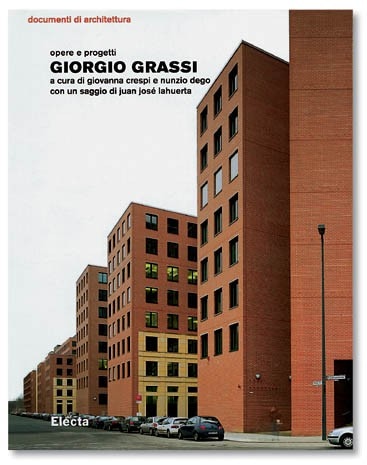Giorgio Grassi. Opere e progetti, A cura di Giovanna Crespi e Nunzio Dego, Electa, Milano 2004 (pp. 460, € 58,00)
In the second edition of Controspazio, published in October 1974, Antonio Monestiroli wrote: “Giorgio Grassi is placed in the architectural debate with his designs and theoretical writings presented here. My immediate observation as to what I consider more important is that these designs and theoretical works directly refer to one another in a rather unique way. It is therefore possible to think of Grassi’s designs as the experimental and inevitable moment in his theory, which is thereby given the elements to develop. Reciprocally, the work of designing is an irreplaceable moment in the definition of theoretical principles, and in this work Grassi attempts to establish the particular and overall value of design choices, so that their generality and thus transferability stand out.”
From these words, theoretical consideration and design appear to be inseparable and reveal the bond to the profession. Thirty years on, the nature of Juan José Lahuerta’s reflection is no different, and in the fine introductory essay on the complete works of Giorgio Grassi, his idea of architecture is explained: “…We must once again place the word ‘construction’ at the centre of our analysis. The key is in shifting its importance from ‘building’ to ‘logic’, or to put it even more clearly, to the ‘logical process’.” In other words Grassi holds an idea of architecture as an intellectual process determined by its reference to a collection of fixed elements and their combination always in keeping with the same evident order.
Thus the choice of basing research on objective and general sources and finding a reference to a unity of thought in history leads the author to seek the signs of this work in history in order to understand its essence and the reason for its permanence. Grassi adopts history as an object of reflection. In fact, over the years there has been no dearth of opportunities for confrontation with architecture of the past, both in his designs and writings. Thus the architects and texts that Grassi studies (Heinrich Tessenow, Ernst May and Ludwig Hilbeseimer) are re-proposed because of the shared poetic and approach. Through the re-proposition of these architects’ works, Lahuerta illustrates Grassi’s desire to offer “above all an explanation of the ‘essential conditions’ of architecture, and therefore a definition of it in terms concurrent with its character.
He understands architecture as a process or a logical progression, following rules imposed by a precise reasoning. This reasoning is the object that Grassi identifies in developing his position, describing it as a formal definition and simplification whose end consists in the revelation of architecture’s essential principles: the same redundancy with which he argues it encapsulates the character illustrated by the definition. Definition and definite are thus enclosed in the same circle.” In this varied and well-documented book edited by Giovanna Crespi and Nunzio Dego, the wealth of iconographic apparatus has the effect of presenting us with highly emotive architecture, especially in the restorations and completions.
The best known and perhaps most fascinating is the completion of the theatre in legendary Sagunto. Here the essentiality of the new creates a “dialogue” with the ruins in which it seems that time has not passed, that the first naturally derives from the second, with a relationship almost of affiliation that bridges the centuries. In this way history takes shape first in the grand construction and then reappears in the second, which is simply cleaner and more essential, but neither contrasting nor competing. It is simply the result of an architectural culture that sinks its roots into the ancient to draw its lifeblood. Grassi’s poetic is dictated by the necessity to overcome the contrast between past and present to be set in a timeless perspective, in reaching out to a primary and absolute time and space.
The book therefore documents Grassi’s research, whose work constantly tackles the experience of ancient architecture, demanding an affiliation that is opposed to the redundancy of the contemporary image. “Hence, writes Grassi, the choice of, let us say, mediocrity effected by these designs in order to be above all lucid and clear. This choice is opposed to the certainly more gratifying option of standing out and being distinguishable, giving rise to the final appearance of incomplete things, seemingly left half-finished. It is evident in more or less all my designs, and is the inevitable consequence of a work that most of all seeks to measure, by the usual means, how far it is possible to be true, or at least credible.”
Claudio Camponogara Architect


